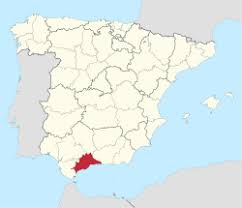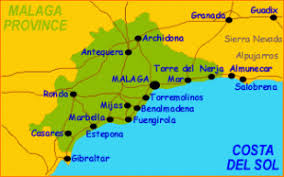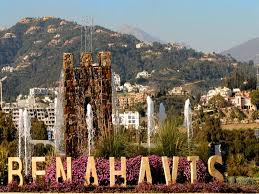 Over the course of the last ten years 70 per cent of new residents in Málaga province came from abroad.
Over the course of the last ten years 70 per cent of new residents in Málaga province came from abroad.
Two in 10 people living in the area were born abroad, with the British and the Moroccans occupying the top two spots and the Argentinians a distant third.
Diagram courtesy of Diario Sur
By Paul Whitelock
Wednesday, 30 October 2024
From the Phoenicians thousands of years ago to the British in the last half century, the province of Málaga has been a draw for other cultures and nationalities throughout the ages.


Map of Spain with Malaga in red [Wikipedia] Malaga province [Absolute Axarquia]
In recent decades, this destination has become a permanent place to live for many foreigners as somewhere to live and work, attracted by the good weather, the lifestyle, cheaper prices and the beauty and variety of the area, from snowy peaks to sun-drenched beaches.


Costa del Sol beaches [Photos courtesy of Malaga Airport and Espacar]
Survey of the last 10 years
From 2011 to 2021 the population of Málaga province, which includes the Costa del Sol grew by 6.7%. This translates into 106,848 new residents, of whom 75,251 (70.4%) were born abroad.
In total 341,751 people of foreign origin reside in the province, 20.2% of the total population of the area. This figure, according to the data for 2021.
Over those ten years, the number of foreign residents has grown by 28.2%, according to data from the population and housing census carried out by the Instituto Nacional de Estadistica (National Statistics Institute) in 2021.
This survey was the latest, most detailed available based on returns from local councils.
It showed that the largest group over the ten years was British, followed by Moroccans and Argentinians. People from countries where there is war or political instability have increased massively, eg Ukraine, Argentina, Colombia and Venezuela. Oddly there has been a large increase from France, possibly for economic reasons.
***
Top 10 countries of origin
Residents of Málaga province born abroad
by total number in 2021
| |
| |
País
|
Personas
|
Variación %
|
|
1
|
Reino Unido
|
50.721
|
−0,9%
|
|
2
|
Marruecos
|
50.397
|
34,2%
|
|
3
|
Argentina
|
25.113
|
6,0%
|
|
4
|
Colombia
|
14.742
|
52,0%
|
|
5
|
Alemania
|
12.564
|
−6,6%
|
|
6
|
Ucrania
|
11.394
|
86,6%
|
|
7
|
Francia
|
10.428
|
34,4%
|
|
8
|
Rumanía
|
10.251
|
11,4%
|
|
9
|
Venezuela
|
10.176
|
240,3%
|
|
10
|
Paraguay
|
9.735
|
1,9%
|
Variation since 2011
Table: Diario SUR
Source: Censo de Población y Viviendas, INE
***
What the figures reveal
The United Kingdom continues to be the most represented nation in the province with 50,721 people. It is also the one that occupies first place in the ranking of foreign residents in 57 municipalities.
But although they are still the majority, the British, along with immigrants from Germany, have shown a fall in numbers since 2011 (-0.9% and -6.6% respectively).
This is the opposite of the number of Moroccan-born inhabitants, with a variation of 34.2% in these ten years and a figure of 50,397 compatriots in 2021 - only 324 people away from unseating the United Kingdom in first place.
Despite these figures, the population of Moroccan origin only leads the ranking of countries in 15 municipalities in the province, compared to 57 in which the United Kingdom heads the list. However, the Moroccan-dominated ones are large towns and cities such as Málaga City, Marbella, Torremolinos, Vélez-Málaga, and Ronda.

View of Malaga City from Mt. Gibralfaro [Wikipedia]
In third position in the province are immigrants from Argentina, although way behind the British and Moroccans with 25,113 representatives. The largest group resides in Málaga City (6,018) and the largest proportion of the total population in Benalmádena (3.9%).
The United Kingdom continues to be the most represented nation in the province with 50,721 people. It is also, as indicated above, the one that occupies first position in the ranking of foreign residents in the most municipalities, 57 out of the 103 local council districts.
Among the municipalities with the most foreign-born residents are the most populated towns in the province such as Málaga city (73,965 foreigners), Marbella (50,070) and Fuengirola (34,134).
If the ranking were based on the proportion of the total number of residents, it is Benahavís which would occupy first place, as 6 out of 10 inhabitants there are of foreign origin. Benahavís is followed by Cómpeta with 43.3% and Sayalonga with 42.2%.

Benahavis [Photo: Visit Andalucia]
If only municipalities with more than 20,000 inhabitants are measured, Fuengirola has the highest proportion of foreign residents with 41.6% and Marbella has experienced the highest percentage variation in ten years (41.3%).
In all the large municipalities in the province of Málaga, the difference between 2011 and 2021 in foreign residents is positive, except in one area: Ronda, where I live, which saw a drop of 5.5%.

Puente Nuevo, Ronda [Photo: Fenix.info]
Disadvantages
Although foreigners investing in property in Spain, contracting local services and shopping in the local shops and supermarkets are undoubtedly a good thing for the Spanish economy, they bring some challenges.
Prices of everything in areas with a high proportion of wealthy foreigners inevitably rise, cf. Benahavís, Puerto Banús, Marbella, Cádiz.
And the supply of affordable apartments for long-term rental by Spanish workers is reduced as owners find that short-term holiday lets via AirBnb or booking.com are more lucrative.
Not to mention, overcrowding. Ronda, where I live, is over-run daily from around 10.30 am until 4.00 pm by hordes of day-tourists coached in from their holiday bases on the coast. And that happens all year round.
But, I say: "Live and let live ….."
Footnote:
Given the importance of foreign immigrants and tourists to Spain’s economy, it is surprising that there is so much anti-foreigner feeling in many cities, eg Barcelona, Valencia, Málaga, Cádiz, where there have been a number of anti-foreigner demonstrations. Barcelona aims to shut down AirBnb and similar companies from 2028.

Click on the image and then the arrow or click here:
Anti-tourism protests across Spain continue despite economic growth | BBC News
All I would say is "Beware of biting the hand that feeds you!" Málaga without tourists would soon die! Cádiz also, I suspect. Barcelona has other industries so will not be so badly affected.
© Paul Whitelock
Acknowledgements:
Censo de Población y Viviendas
Encarni Hinojosa
Instituto Nacional de Estadística (INE)
SUR in English
Photos:
Absolut Axarquia
BBC News
Diario Sur
Espacar
FaceBook
Fenix.info
Malaga Airport
Visit Andalucia
Wikipedia
Links:
Anti-tourism protests across Spain continue despite economic growth | BBC News
Tags:
Absolut Axarquia, AirBnb, anti-foreigner demonstrations, Argentina, A View from the Mountains, Barcelona, Benahavís, booking.com, BBC News, Cádiz, Censo de Población y Viviendas, Colombia, Cómpeta, Costa del Sol, Diario Sur, Encarni Hinojosa, Espacar, FaceBook, Fenix.info, foreigners, France, Fuengirola, immigrants, Instituto Nacional de Estadística (INE), Málaga, Malaga Airport, Marbella, Moroccan, Paul Whitelock, Puerto Banús, Ronda, Sayalonga, SUR in English, Torremolinos, Ukraine, Valencia, Vélez-Málaga, Venezuela, Visit Andalucia, Wikipedia